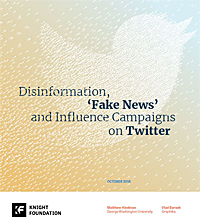


Fake News, the 2016 Election, and How to Deal with Bots in a Crisis
[by Howard Fencl, Hennes Communications]
The 2016 election was inextricably entwined in social media “bot” controversy that may challenge you today in a crisis at your organization. Bots are automated accounts that can be unleashed to spread information – or disinformation – in the blink of an eye across the web using Twitter and other popular social media platforms.
An eye-opening new study from the Knight Foundation says up to 70% of social media accounts spreading fake or conspiracy news are likely bots. An astonishing number.
If your company is besieged by a crisis and you’re being dragged through the muck in social media posts multiplying by the moment, how can you tell if bots are at work? Start with some simple, common-sense questions:
- Does the account look and sound like a real person?
- Is the profile photo of the account a stock photo? (A reverse image search can sometimes help determine this)
- Is this an account or a series of accounts with very similar messages about a subject?
If your answers are (1) NO; (2) YES; and (3) YES, here are practical approaches you can use to fight back a bot attack trashing your company’s good name:
1. It’s important to have a crisis communications plan. This is not the same as an operational business continuity plan, which details steps to take to stay in business when there’s a natural disaster, power grid attack, etc. A crisis communications plan is the best way to ensure your organization is prepared to respond quickly and effectively, preserving – and perhaps enhancing – your organization’s reputation when a crisis hits.
A well-crafted crisis communications plan will include a risk assessment or vulnerability audit to make sure you’re aggregating all of your company’s likely threat scenarios with input from a broad range of experts in your organization. A bot attack is one of the threats you should anticipate for every scenario. Accordingly, the plan should include tweets and Facebook posts with your key messages ready to post at a moment’s notice.
A crisis plan greatly reduces your pain when an issue flares up, and gives you the speed you need in an attack – you’ve got planned, approved, legally vetted responses that can be adapted to your situation and quickly distributed.
2. Build strong relationships with your key audiences on social media BEFORE a crisis strikes. It’s reputation equity you can borrow against: When you find yourself under attack, you’ve got allies at the ready to come to your aid and help disseminate your important messages on social media.
3. Monitor social media closely. Post your key messages on social media sites when you see bot posts gaining traction. When there are thousands of likes or retweets, act. Post your messages and post them transparently, making sure you identify yourself, including your name and title.
4. Get your statement to conventional media as quickly as possible. They have a big megaphone and tens of thousands of social media followers. If your issue is newsworthy and they report on it, you’ll leverage their social media reach.
5. Take it offline with your most important audiences. Old school strategy: pick up the phone and CALL your biggest investors, your best customers, your key business partners and let them know you’re under a bot attack and what the facts of the matter are. Follow up with an email that shares your media statement and links to your company’s social media accounts so they have your side of the story in writing. When they retweet, share or like your messages, you’re leveraging the power of their social audiences as well.
6. Report the bot activity to the social networks. Depending on the platform, the network may shut down specific automated accounts.